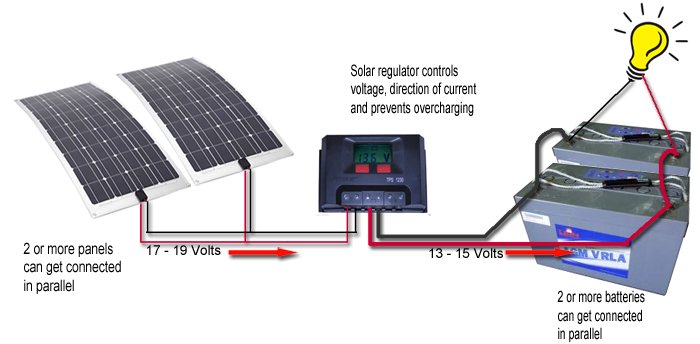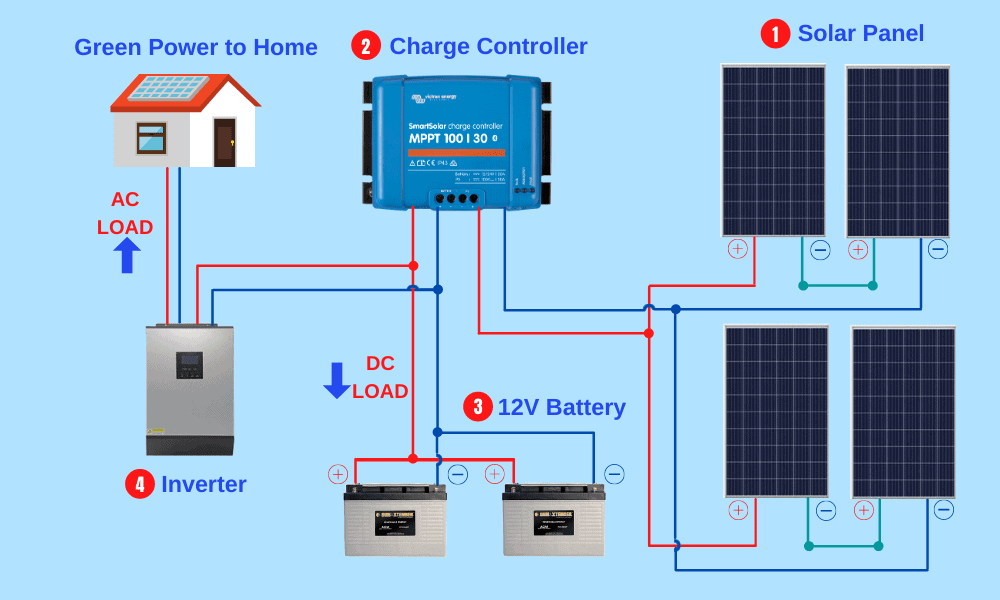“Basic solar wiring with charge controller”
Understanding Solar Panels and Wiring
Solar panels are made up of photovoltaic (PV) cells, which generate direct current (DC) electricity when exposed to sunlight. The DC power is then collected and sent through a wiring system to a charge controller, which regulates the energy flow and charges a battery bank. The battery bank stores excess energy for later use, providing a stable power supply during periods of low sunlight or at night.
When it comes to solar panel wiring, there are several key considerations:
- Series and Parallel Connections: Solar panels can be connected in series, parallel, or a combination of both. Series connections increase the voltage, while parallel connections increase the current. The choice of connection depends on the system’s design and the type of charge controller used.
- Wire Sizing: The wire size is critical in solar panel wiring. Undersized wires can lead to energy losses, overheating, and even fires. The wire size should be selected based on the system’s current and voltage requirements.
- Connectors and Terminals: Connectors and terminals should be designed for outdoor use and able to withstand the elements. They should also be compatible with the wire gauge and type used in the system.
Introduction to Charge Controllers
A charge controller is an essential component in a solar panel system, responsible for regulating the energy flow from the solar panels to the battery bank. The charge controller’s primary function is to:

- Prevent Overcharging: The charge controller prevents the battery bank from overcharging, which can lead to damage and reduced lifespan.
- Prevent Over-Discharging: The charge controller also prevents the battery bank from over-discharging, which can cause damage and reduce the battery’s lifespan.
- Optimize Energy Harvesting: The charge controller optimizes energy harvesting by ensuring the solar panels operate at their maximum power point (MPP).

There are two main types of charge controllers:
- Pulse Width Modulation (PWM) Charge Controllers: PWM charge controllers use a pulse width modulation technique to regulate the energy flow. They are suitable for smaller systems and are often less expensive than MPPT charge controllers.
- Maximum Power Point Tracking (MPPT) Charge Controllers: MPPT charge controllers use an algorithm to track the maximum power point of the solar panels, maximizing energy harvesting and efficiency. They are suitable for larger systems and offer higher efficiency than PWM charge controllers.

Connecting Solar Panels to a Charge Controller
To connect solar panels to a charge controller, follow these steps:
- Determine the System’s Requirements: Determine the system’s voltage and current requirements, as well as the type of charge controller used.
- Select the Correct Wire Size: Select the correct wire size based on the system’s current and voltage requirements.
- Connect the Solar Panels: Connect the solar panels in series or parallel, depending on the system’s design.
- Connect the Charge Controller: Connect the charge controller to the solar panels, battery bank, and load (if applicable).
- Configure the Charge Controller: Configure the charge controller according to the manufacturer’s instructions and the system’s requirements.
Safety Considerations
When working with solar panel wiring and charge controllers, safety is paramount. Always follow these safety guidelines:
- Use Protective Gear: Use protective gear, such as gloves and safety glasses, when working with electrical systems.
- Disconnect the System: Disconnect the system before performing any maintenance or repairs.
- Follow Manufacturer’s Instructions: Follow the manufacturer’s instructions for the charge controller, solar panels, and other components.
- Use Compatible Components: Use compatible components, such as wire gauge and type, to ensure safe and efficient operation.
Troubleshooting Common Issues
Common issues that may arise in a solar panel system with a charge controller include:
- Undercharging or Overcharging: Check the charge controller’s settings and adjust as necessary.
- Low Voltage or Current: Check the wire size and connections, and ensure the solar panels are clean and free of debris.
- Error Messages: Consult the charge controller’s manual and reset the device if necessary.
Conclusion
In conclusion, basic solar wiring with a charge controller requires a comprehensive understanding of solar panel wiring, charge controllers, and safety considerations. By following the guidelines outlined in this article, you can ensure a safe and efficient solar panel system that meets your energy needs. Remember to always follow the manufacturer’s instructions and safety guidelines when working with electrical systems. As the world continues to shift towards renewable energy sources, understanding the basics of solar wiring and charge controllers will become increasingly important for homeowners, businesses, and industries alike.
Recommended Practices
To ensure a safe and efficient solar panel system, follow these recommended practices:
- Regular Maintenance: Regularly inspect and maintain the solar panel system to ensure optimal performance.
- Monitor the System: Monitor the system’s performance using a monitoring system or software.
- Upgrade Components: Upgrade components, such as the charge controller or solar panels, as necessary to ensure optimal performance and efficiency.
- Consult a Professional: Consult a professional if you’re unsure about any aspect of the solar panel system or charge controller.
By following these guidelines and recommended practices, you can ensure a safe and efficient solar panel system that meets your energy needs and contributes to a sustainable future.





